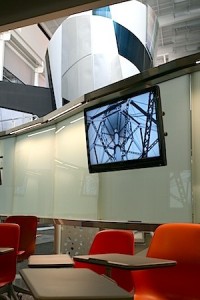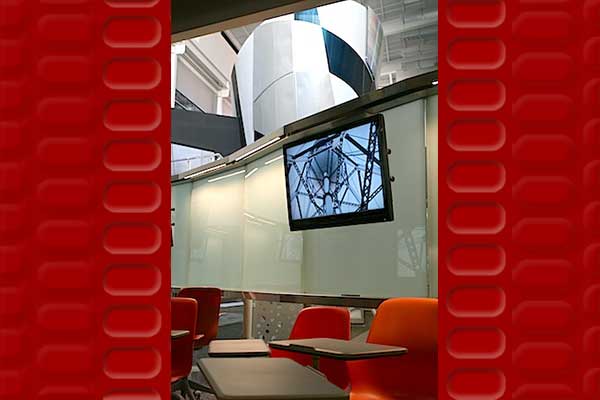 This week, Iowa State’s College of Engineering launched leading-edge classroom technology in an open concept room carved from unused atrium space.
This week, Iowa State’s College of Engineering launched leading-edge classroom technology in an open concept room carved from unused atrium space.
Tucked in a large alcove near the central stairs of Howe Hall, the classroom for up to 120 students features 12 monitors throughout, backlit white boards, moveable chairs, and a large display screen, projector, and microphone for instructors. The room is open concept, divided from the rest of the atrium by a curving translucent glass wall that is open at the top and both ends. Monitors can be used individually for student team work or simultaneously broadcast the instructor’s multimedia presentation. The display technology can be operated from an iPad or iPhone.
It’s a substantial upgrade for a former lounge area that used to be the go-to spot for engineering students to catch a nap.
Rich Wlezien, professor and Vance and Arlene Coffman Endowed Department Chair in Aerospace Engineering, taught his first Introduction to Aerospace Engineering lecture here this week.
“We’ve had good feedback from the students. We’re going to do a lot of experiments with the classroom, trying to learn how to take best advantage of all its possibilities. Right now, we’re in more of a conventional classroom mode, but we’re moving in the direction of students working in groups and a more interactive learning experience.”
This sort of collaborative environment is the goal behind the recent educational concept called next generation classrooms, where technology and flexible arrangements of equipment and students are conducive to a participatory, interactive learning experience.
“While we’ve seen the next generation classroom concept being incorporated at other universities for classrooms in the 20- to 30-person size range, we have not seen anyone doing it at this scale, for the larger size classes. And not too many are doing an open classroom at all. I think we are breaking out of that paradigm,” said Tom Brumm, a professor-in-charge of Engineering-LAS Online Learning, and a faculty member in agricultural and biosystems engineering.
The open concept, Wlezien said, is fostering that sense of participatory education for those not even involved in the class.
“Every day at 1 p.m. we have a prospective student tour go through the building, and I see them standing around outside or up on the balcony getting a free lecture,” he said. “I see people stopping on the stairs to listen all the time. At first it’s a little bit intimidating, but you get used to it. My view if this works out, I can see a whole lot more of these going up. You can put them together a lot more easily than the traditional classroom, and the money normally put into brick and mortar can be put into electronics.”
The open classroom is also becoming the spot for student teams. When there is no class being held, students pull up chairs around a monitor, plug in a laptop computer, and work together on projects or assignments.
“Even before we had the cables installed for students to connect to the flat-screen monitors, they were using them. They brought their own cables,” Brumm said. “Students recognized immediately that this is great space for working together.”
Wlezien hatched the idea for the open classroom a last year, when he found his course was assigned to a less convenient classroom space on the other side of campus.
Instead of making the trek, he set up folding chairs and a screen, and taught his lectures in the open atrium space at Howe Hall.
“At the time, I had no idea how it would go,” Wlezien said. “Honestly, there were faculty members who told me they thought it was a disaster in the making. To everyone’s surprise, it worked really well. The students liked it better than being crammed into a conventional classroom and attendance was better.”
That initial experiment led to the College of Engineering, the aerospace engineering department, and Engineering-LAS Online Learning tapping strategic initiative project funds through the provost’s office, at a cost of $250,000. Iowa State’s facilities planning and management constructed the space according to a design by Smith Metzger, an architectural firm from Des Moines.
- See related WHO-TV story, UNIQUE CLASSROOM: ISU Lounge Transformed.
